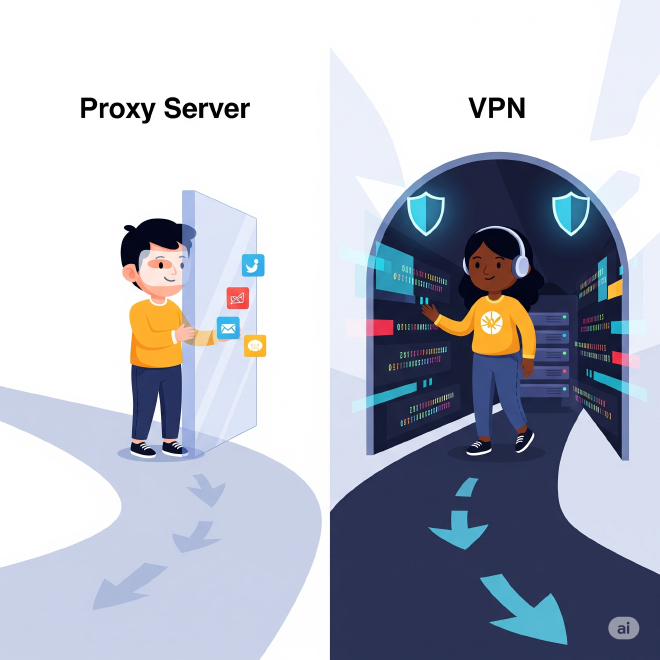
Proxy Servers vs VPNs: Understanding the Gatekeepers of Your Internet Privacy#
Network connectivity issues and privacy concerns frequently arise when working with enterprise environmentss.. Understanding the technical distinctions between proxies and VPNs becomes crucial when troubleshooting access issues or implementing security policies.
When you want to browse the web privately, two technologies often come up: proxy servers and VPNs. While both act as intermediaries between you and the internet, they operate at different layers and serve distinct purposes—knowledge that proves invaluable when diagnosing connectivity problems.
What is a Proxy Server?#
A proxy server functions as an intermediary device that forwards client requests to destination servers while masking the original source. Enterprise networks commonly implement proxies at the application layer for traffic filtering, content caching, and access control.
How Proxies Work:#
→ Sits between your device and the internet → Masks your IP address with their own → Can filter, log, or cache content
Key Benefits:#
→ Privacy: Hides your real IP address
→ Security: Acts as a firewall against malicious traffic
→ Performance: Caches frequently accessed content for faster loading
→ Control: Allows network admins to monitor/restrict web access
Types of Proxies:#
Forward Proxy (most common): — Handles outbound client requests from internal networks — Example: Corporate web filters implementing content restrictions — Operates transparently or requires explicit client configuration
Reverse Proxy: — Accepts requests from external clients on behalf of backend servers — Enables load distribution and SSL termination — Commonly used in web server architectures
Proxy Configuration Levels:#
— System-level: All traffic routes through proxy — Application-level: Only specific apps (like browsers) use proxy
Note: Application-specific proxy configurations can create scenarios where Layer 7 applications behave inconsistently — a key consideration when troubleshooting network connectivity.
What is a VPN?#
A Virtual Private Network establishes an encrypted tunnel between client and server, creating a secure overlay network across untrusted infrastructure. VPNs operate at Layer 3 (Network Layer), encrypting all IP traffic regardless of the application protocol.
Read more: How Tunneling Secures Your Connection
How VPNs Work:#
→ Encrypts all data between your device and VPN server → Routes all network traffic through the tunnel → Completely masks your IP and location
Key Benefits:
→ IPSec/SSL Encryption: Protects data integrity and confidentiality
→ Network Layer Security: Comprehensive traffic protection
→ Remote Access: Secure connectivity to private networks
→ Protocol Agnostic: Supports all IP-based communications
Proxy vs VPN: Key Differences#
| Feature | Proxy Server | VPN |
|---|---|---|
| OSI Layer | Application (Layer 7) | Network (Layer 3) |
| Encryption | No | Yes (IPSec/SSL) |
| Traffic Coverage | Application-specific | All IP traffic |
| Performance Impact | Minimal (with cache) | Moderate (encryption overhead) |
| Configuration Scope | Per-application | System-wide |
| Cost | Often free | Typically subscription-based |
| Reliability | Variable | More consistent |
| NAT Traversal | Not applicable | May require configuration |
When to Use Each:#
Choose a Proxy when: → You need simple IP masking → Only web traffic needs protection → You want caching for faster browsing → You’re dealing with application-specific restrictions
Choose a VPN when: → You need full encryption → Privacy is critical (e.g., public WiFi) → Accessing sensitive data remotely → You want comprehensive protection without per-app configuration
Technical consideration: VPN connectivity failures commonly result from MTU size mismatches, DNS resolution conflicts, or split-tunnel routing issues. Systematic troubleshooting should examine these parameters before attributing problems to the VPN service itself.
Reverse Proxy vs Load Balancer#
While often confused, these serve different purposes—a distinction that matters when you’re trying to diagnose why a web application isn’t responding properly:
Reverse Proxy: — Single point of entry implementing server load distribution — Handles SSL/TLS termination and certificate management — Functions as a gateway for client-to-server communication — Often implements caching and compression mechanisms
Load Balancer: — Distributes incoming requests across multiple backend servers — Monitors server health and adjusts traffic distribution accordingly — Focuses on optimizing resource utilization and availability — Can operate at Layer 4 (Transport) or Layer 7 (Application)
Many modern solutions (like NGINX) integrate both functionalities, providing comprehensive application delivery services while simplifying infrastructure management.
Final Thoughts#
Understanding the architectural differences between proxies and VPNs is fundamental for implementing effective network security policies. Proxies operate at the application layer providing granular traffic control, while VPNs create secure network-layer tunnels for comprehensive data protection.
For basic traffic filtering and content access control, proxy implementations offer sufficient functionality with minimal overhead. For secure remote access and data confidentiality—particularly when accessing sensitive corporate resources or traversing untrusted networks—VPN deployment provides the necessary encryption and authentication mechanisms.

